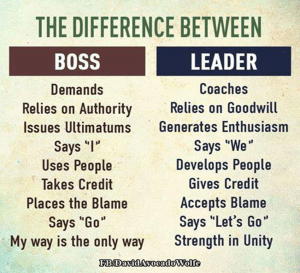Are you a Leader or a Manager?

A close friend sent me this chart:
I see this chart as outlining some of the differences between leaders and managers. There is such a significant difference between the two. Here are some of my thoughts:
Managers manage and focus on the existing reality. Leaders always look forward and think about how to create new realities.
I often hear managers brag about how their team’s performance is the best in the region or group. Leaders, on the other hand, seem to care less about how to reach the top of the current scale. They seem to be more interested in how to put their teams at the bottom of the next-level scale.
Managers ask for permission, while leaders ask for forgiveness. Managers tend to be more hesitant about taking initiative and doing things that haven’t been done before. Leaders tend to be more comfortable making bolder decisions and overall their tolerance for taking risk is higher.
Leaders seem to always stand in the bigger picture and destination. They are concerned with the question “Where do we need to get to?” while managers are constantly looking for “What do we need to do?”
- Managers strive to drive discipline, consistency, and order. They are often afraid to shake things. However, leaders promote and expect disruptive thinking and productive chaos that shakes things.
- Compliance is very important to managers because they see it as the route to efficiency. For leaders, compliance is the enemy. The most powerful leaders I know constantly look for how to inspire ownership and commitment in their people.
- Compliance always promotes an environment of fear. Ownership and commitment inspire courage and innovation.
- Managers drive things through their authority. Leaders drive things through their personality and charisma. Even when they have the authority to mandate things, leaders choose the path of inspiring and enlisting their people in their vision.
While there is a significant difference between the orientation, demeanor, energy, qualities, and skills of leaders and managers, both are required to make things work. Both have a key role in achieving the best outcomes. And both need to work very closely to complement each other.
In the most powerful teams that I have seen, the leaders facilitated the creation of a bold vision and they inspired everyone to get on board and own them. Managers helped them to turn their bold visions into realities and results.
Unfortunately, too often I see managers playing the roles of leaders. They stifle their team’s energy, innovation, and success.
I also see leaders who don’t empower and use their managers wisely and effectively. Things don’t get done, people don’t see progress, and over time, they get frustrated and discouraged.
When you have clarity and harmony between the two, you can form the best teams who can drive the greatest change, progress, and accomplishments.
So, are you a leader or manager?
